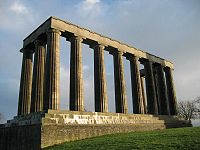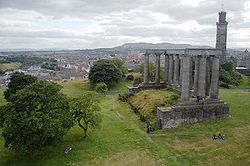
National Monument, Edinburgh
Encyclopedia


Edinburgh
Edinburgh is the capital city of Scotland, the second largest city in Scotland, and the eighth most populous in the United Kingdom. The City of Edinburgh Council governs one of Scotland's 32 local government council areas. The council area includes urban Edinburgh and a rural area...
. It is Scotland's national memorial to the Scottish soldiers and sailors who died fighting in the Napoleonic Wars
Napoleonic Wars
The Napoleonic Wars were a series of wars declared against Napoleon's French Empire by opposing coalitions that ran from 1803 to 1815. As a continuation of the wars sparked by the French Revolution of 1789, they revolutionised European armies and played out on an unprecedented scale, mainly due to...
, and was intended, according to the inscription, to be "A Memorial of the Past and Incentive to the Future Heroism of the Men of Scotland".
The monument dominates the top of Calton Hill, just to the east of Edinburgh's New Town
New Town, Edinburgh
The New Town is a central area of Edinburgh, the capital of Scotland. It is often considered to be a masterpiece of city planning, and is a UNESCO World Heritage Site...
. It was designed during 1823-6 by Charles Robert Cockerell
Charles Robert Cockerell
Charles Robert Cockerell was an English architect, archaeologist, and writer.-Life:Charles Robert Cockerell was educated at Westminster School from 1802. From the age of sixteen, he trained in the architectural practice of his father, Samuel Pepys Cockerell...
and William Henry Playfair
William Henry Playfair
William Henry Playfair FRSE was one of the greatest Scottish architects of the 19th century, designer of many of Edinburgh's neo-classical landmarks in the New Town....
and is modelled upon the Parthenon
Parthenon
The Parthenon is a temple on the Athenian Acropolis, Greece, dedicated to the Greek goddess Athena, whom the people of Athens considered their virgin patron. Its construction began in 447 BC when the Athenian Empire was at the height of its power. It was completed in 438 BC, although...
in Athens
Athens
Athens , is the capital and largest city of Greece. Athens dominates the Attica region and is one of the world's oldest cities, as its recorded history spans around 3,400 years. Classical Athens was a powerful city-state...
. Construction started in 1826 and the building was left in its unfinished state in 1829.
Construction
As early as 1816, the Highland Society of Scotland called for the construction of a national monument to commemorate the fallen in the Napoleonic Wars. Initially the MoundThe Mound
The Mound is an artificial hill in central Edinburgh, Scotland, which connects Edinburgh's New Town and Old Town. It was formed by dumping around 1,501,000 cartloads of earth excavated from the foundations of the New Town into the drained Nor Loch which forms today's Princes Street Gardens. The...
was considered as a site, but was rejected in favour of Calton Hill.
In January 1822, a proposal was put forward to 'erect a facsimile of the Parthenon
Parthenon
The Parthenon is a temple on the Athenian Acropolis, Greece, dedicated to the Greek goddess Athena, whom the people of Athens considered their virgin patron. Its construction began in 447 BC when the Athenian Empire was at the height of its power. It was completed in 438 BC, although...
' at a cost of some £42,000. The appeal found support amongst many prominent Edinburgh residents such as Sir Walter Scott, Henry, Lord Cockburn and Francis, Lord Jeffrey
Francis Jeffrey
Francis Jeffrey, Lord Jeffrey was a Scottish judge and literary critic.He was born in Edinburgh, the son of a clerk in the Court of Session. After attending the Royal High School for six years, he studied at the University of Glasgow from 1787 to May 1789, and at Queen's College, Oxford, from...
. In July 1822 the Royal Association of Contributors to the National Monument of Scotland was incorporated by an Act of Parliament. The foundation stone was laid, amid great pomp and ceremony, the following month.
Sixteen months after the initial appeal, only £16,000 had been found with the possibility of a £10,000 grant from Parliament
Parliament of the United Kingdom
The Parliament of the United Kingdom of Great Britain and Northern Ireland is the supreme legislative body in the United Kingdom, British Crown dependencies and British overseas territories, located in London...
. In 1826, the building was finally commissioned and work began. The builder contracted to execute the work was Messrs William Wallace & Son.
Originally, the building was planned to have extensive catacombs in the area supporting the main structure, to provide a burial place for significant figures, intended as a "Scottish Valhalla". A minute of the Royal Association in 1826 stated that the building was:
-
"to adopt the Temple of Minerva or Parthenon of Athens, as the model of the Monument, and to restore to the civilised world that celebrated and justly admired edifice, without any deviation whatever, excepting the adaptation of the sculpture to the events and achievements of the Scottish Heroes, whose prowess and glory it is destined to commemorate and perpetuate, and part of which monument or building must, in terms of the said Act, be appropriated as a church or place of Divine worship, to be maintained in all time coming by the said Association"
Laying of the foundation stone
The foundation stone, which weighs 6 tons and is 228 feet long by 102 feet broad, was laid on 27 August 1822, during the visit of George IV to Scotland.The Duke of Hamilton (the most senior non-royal Scottish noble and the Grand Master of Scotland) lead a procession of masonic lodge
Masonic Lodge
This article is about the Masonic term for a membership group. For buildings named Masonic Lodge, see Masonic Lodge A Masonic Lodge, often termed a Private Lodge or Constituent Lodge, is the basic organisation of Freemasonry...
s, royal commissioners and other dignitaries from Parliament Square to the top of Calton Hill. The procession was escorted by the Scots Greys
Scots Greys
The Royal Scots Greys was a cavalry regiment of the British Army from 1707 until 1971, when they amalgamated with the 3rd Carabiniers to form The Royal Scots Dragoon Guards ....
and the 3rd Dragoons.
The deposition of the inscription plate
Commemorative plaque
A commemorative plaque, or simply plaque, is a plate of metal, ceramic, stone, wood, or other material, typically attached to a wall, stone, or other vertical surface, and bearing text in memory of an important figure or event...
s in the stone was accompanied by cannon salutes from Edinburgh Castle
Edinburgh Castle
Edinburgh Castle is a fortress which dominates the skyline of the city of Edinburgh, Scotland, from its position atop the volcanic Castle Rock. Human habitation of the site is dated back as far as the 9th century BC, although the nature of early settlement is unclear...
, Salisbury Crags, Leith Fort and the royal squadron lining the roads.
Proposals for completion
Particularly due to the use of high-quality materials, the project ended in 1829 with funds running out. Local legend suggests that the city of GlasgowGlasgow
Glasgow is the largest city in Scotland and third most populous in the United Kingdom. The city is situated on the River Clyde in the country's west central lowlands...
apparently offered to cover the costs but Edinburgh was too proud to accept the other city's charity. As a result, the monument was for long referred to by the nickname Edinburgh's Disgrace or Edinburgh's Folly.
Early proposals for completion work tended to focus on following the original plans, however, during the early 20th century several alternative plans were proposed:
- as a monument to Queen Victoria (1901)
- as a monument commemorating the 1707 Act of Union with EnglandActs of Union 1707The Acts of Union were two Parliamentary Acts - the Union with Scotland Act passed in 1706 by the Parliament of England, and the Union with England Act passed in 1707 by the Parliament of Scotland - which put into effect the terms of the Treaty of Union that had been agreed on 22 July 1706,...
(1907) - as a new Scottish National Gallery (1907)
- as a Scottish Parliament buildingScottish Parliament BuildingThe Scottish Parliament Building is the home of the Scottish Parliament at Holyrood, within the UNESCO World Heritage Site in central Edinburgh. Construction of the building commenced in June 1999 and the Members of the Scottish Parliament held their first debate in the new building on 7...
(1908) - as a memorial to those that fell in the Great War (1918, George Washington BrowneGeorge Washington BrowneSir George Washington Browne FRIBA was a Scottish architect. He was born in Glasgow, and trained there and in London...
)
Subsequent attempts to 'complete' the National Monument have never borne fruit for reasons of either cost or lack of local enthusiasm. A proposal in 2004 met with a mixed reception.
External links
- Photosynth of National Monument
- Archiseek - National Monument
- Edinburgh Architecture - National Monument
- http://www.19thc-artworldwide.org/index.php/component/content/article/58-autumn05article/207-a-building-from-which-derived-qall-that-is-goodq-observations-on-the-intended-reconstruction-of-the-parthenon-on-calton-hill'A Building from which Derived "All that is Good". Observation on the Intended Reconstruction of the Parthenon on Calton Hill' by Marc Fehlmann in the online art magazine Nineteenth-Century Art Worldwide ]

